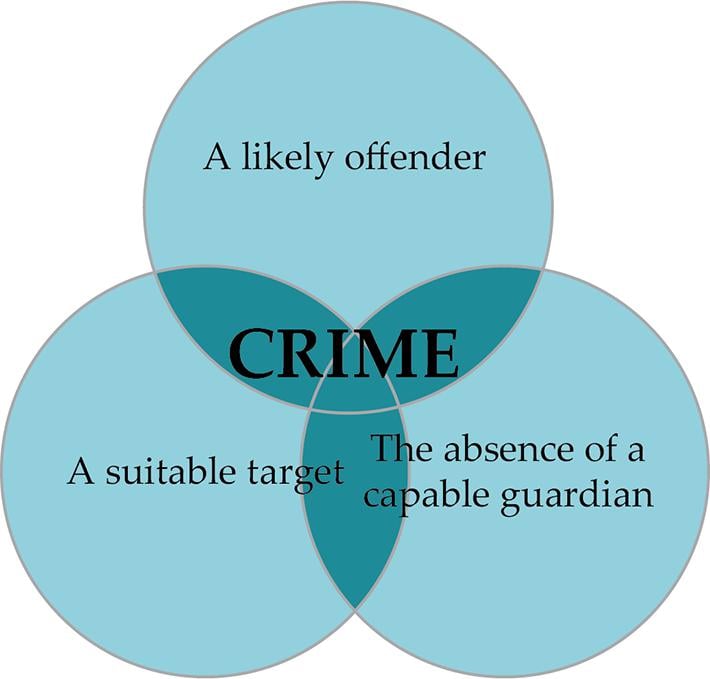Routine activities theory states that crime occurs when a motivated offender encounters a suitable target in the absence of a capable guardian. Rather than focusing on criminality, it examines how changes in routine activities of potential victims and offenders affect crime rates based on availability, proximity, and exposure.
Key Takeaways
- Introduced by Lawrence Cohen and Marcus Felson, routine activities theory is an approach in criminology that relates crime closely to environment, studies it as an event, and underscores its ecological process (Cohen & Felson, 1979).
- Its primary focus on situations of crime, rather than on offenders, distinguishes it from many other criminological theories.
- Often studied in the context of rational choice theory and human ecology, routine activities theory has been utilized extensively to analyze cybercrimes, robberies, and residential burglary.
- Moreover, routine activities theory has been regarded as similar in many respects to lifestyle theory of criminology, and has been applied alongside social disorganization theory in multilevel frameworks in order to understand neighborhood crimes (Hindelang, Gottfredson & Garofalo, 1978).
Theoretical Examples
The macro-level analytic focus of routine activities theory highlights the overarching shifts within the patterns of offender and victim behavior (Cohen, Kluegel & Land, 1981). The theory notably assumes that anyone with the opportunity to commit a crime, can do so.
Routine activities theory further holds that would-be-victims may choose whether to become victims or not via their choices. For example they may avoid dangerous situations, and thereby, decrease their likelihood of becoming victims.
For a crime to occur according to routine activities theory, there must be three elements: firstly, a motivated offender; secondly, a suitable target; and, thirdly, the absence of capable guardians. The combination of these three factors leads to crime.

Motivated Offender
Motivated offenders are individuals with both the capacity and the willingness to commit wrongdoing (Felson & Lawrence, 1980; Miro, 2014). Routine activities theory, unlike other theories of crime, does not seek to explain the willingness of the potential offender.
It avoids investigating deep-seated psychological drives capable of inspiring criminal activity, and holds that the offender’s motivation to engage in criminal activity remains constant.
According to the theory, alterations in the surrounding circumstances would not change the intensity of the motivation, and only factors influencing the offender’s capacity would determine the likelihood of his/her committing the crime (Branic, 2015).
Suitable Target
A suitable target could be either a person or property the motivated offender can readily identify and engage (Nickerson, 2022; Miro, 2014). The situational context and the nature of the wrongdoing may determine the exact form of the suitable target.
In other words, the availability of opportunities as well as the offender’s particular intention may incline him/her to choose a certain target over another. Contrary to what broad trends in crime might suggest, the offender’s personal preferences and perceptions play a crucial role in the evaluation and choice of a target.
The aforementioned perceptions, however, could be significantly shaped by large-scale changes in society that could alter the availability of suitable targets.
Moreover, nonhuman objects such as expensive houses or valuable necklaces can constitute targets for burglary and theft, while a human being occupying or wearing such an object may elicit the attention of the motivated offender (Nickerson, 2022).
The appropriateness of the target, herein, however, seems to be the primary factor determining whether the crime would be committed. The following acronym, VIVA, indicates the criteria whereby the motivated offender would gauge the suitability of a potential target (Miro, 2014).
- Value = the real or symbolic value [from the offender’s perspective] of engaging the target
- Inertia = the suitable target’s weight, shape, size or other physical attributes that function as impediments to the motivated offender
- Visibility = the exposure of a target to an offender, marking it suitable for assault
- Access = the target’s placement and the site’s design increasing the vulnerability to attack
Absence of Capable Guardians
Capable guardians could be individuals or objects that effectively deter criminal conduct via their simple presence in time and space.
This type of either informal or formal guardianship can prevent wrongdoing even when a suitable target has been chosen by a motivated offender (Nickerson, 2022).
For instance, the presence of a police officer close by could make a potential criminal increasingly reluctant to launch an assault. Alternately, ordinary citizens may form community watch associations and patrol the neighborhood to ensure its safety.
Either way, the maintenance of constant surveillance can engender social order and discourage crime. Nonhuman objects capable of providing guardianship may include security cameras, burglary alarms, fences and walls.
The variety of possible guardians implies that neighborhood planning and urban layout can play a potent role in reducing crime (Felson and Boba, 2010).
Criticism of the Theory
Routine activities theory is a macro theory that leaves out many components relevant to criminology (Nickerson, 2022). For example, the theory fails to consider criminal opportunity contexts, or those circumstances inducing the convergence of motivated offenders and their suitable targets (Wilcox, Land, and Hunt, 2003).
Additionally, routine activities theory pays no heed to what might constitute an incentive for an offender (Clarke and Cornish, 1985).
It bears noting that an offender might construe a certain target as either suitable or unsuitable based on a distinct and uncommon motivation.
Further Information
- Cohen, L. E., & Felson, M. (1979). Social change and crime rate trends: A routine activity approach. American sociological review, 588-608.
- Yar, M. (2005). The Novelty of ‘Cybercrime’ An Assessment in Light of Routine Activity Theory. European Journal of Criminology, 2(4), 407-427.
References
Branic, N. (2015). Routine activities theory. The encyclopedia of crime and punishment, 1-3.
Clarke, R. V., & Cornish, D. B. (1985). Modeling offenders” decisions: A framework for research and policy. Crime and justice, 6, 147-185.
Cohen, Lawrence E.; Felson, Marcus (1979). “Social Change and Crime Rate Trends: A Routine Activity Approach”. American Sociological Review. 44 (4): 588–608.
Cohen, Lawrence E.; Kluegel, James R.; Land, Kenneth C. (1981). “Social Inequality and Predatory Criminal Victimization: An Exposition and Test of A Formal Theory”. American Sociological Review. 46(5): 505–524. doi:10.2307/2094935
Felson, M., & Boba, R. L. (Eds.). (2010). Crime and everyday life. Sage.
Felson, Marcus; Cohen, Lawrence E. (1980). “Human Ecology and Crime: A Routine Activity Approach”. Human Ecology. 8 (4): 389–406. doi:10.1007/BF01561001. JSTOR 4602572. S2CID 154738413.
Hindelang, M. J.; Gottfredson, M. R.; Garofalo, J. (1978). Victims of personal crime: An empirical foundation for a theory of personal victimization. Cambridge, Massachusetts: Ballinger. ISBN 978-0-88410-793-4.
Miro, Fernando (January 31, 2014). “Routine Activity Theory”. In Miller, J. Mitchell (ed.). The Encyclopedia of Theoretical Criminology (1st ed.). doi:10.1002/9781118517390
Nickerson, C. (2022). Routine activities theory. Simply Psychology. www.simplypsychology.org/routine-activities-theory.html
Wilcox, P., Land, K. C., Hunt, S. A. (2003). Criminal circumstance: A dynamic, multi-contextual criminal opportunity theory. New York, NY: Aldine de Gruyter.
Wilcox, P., Quisenberry, N., & Jones, S. (2003). The built environment and community crime risk interpretation. Journal of Research in crime and delinquency, 40(3), 322-345.

